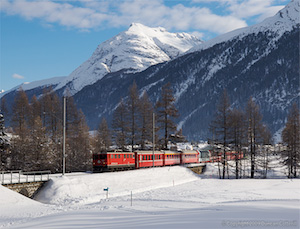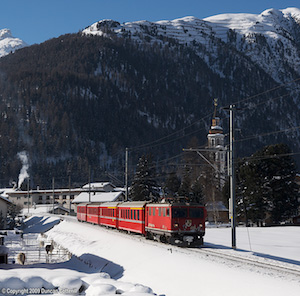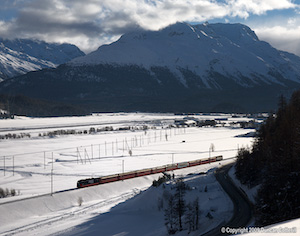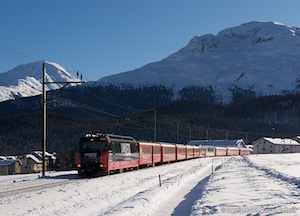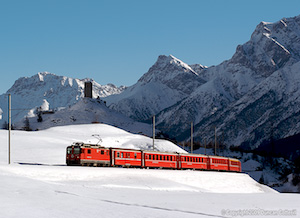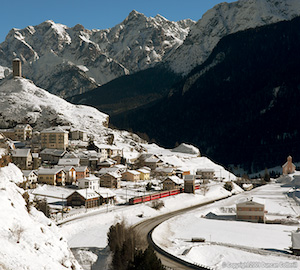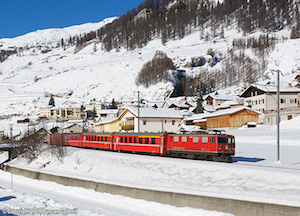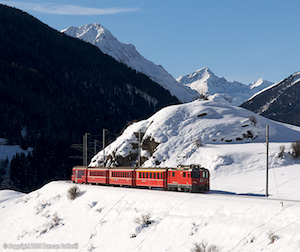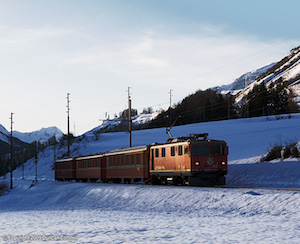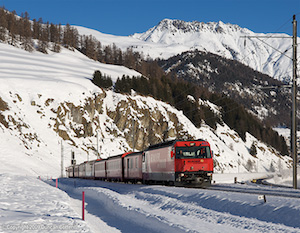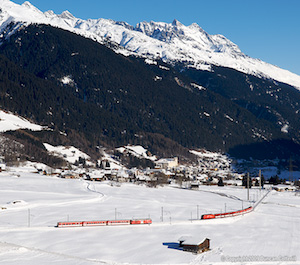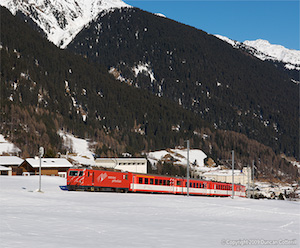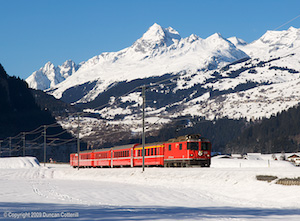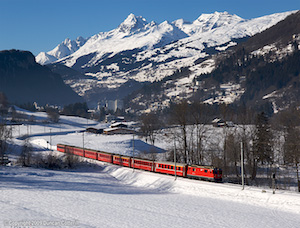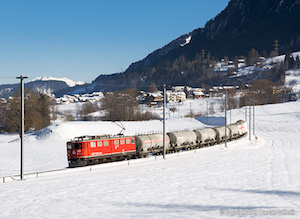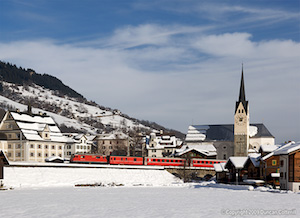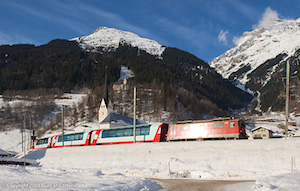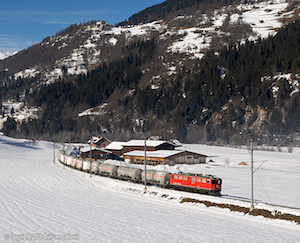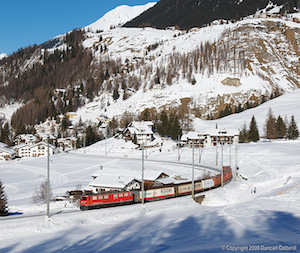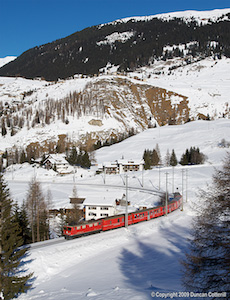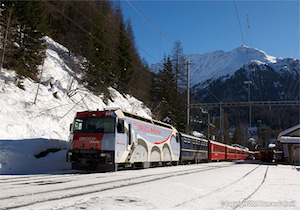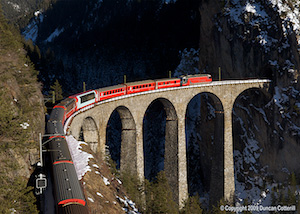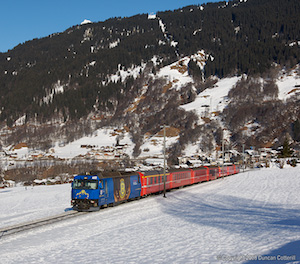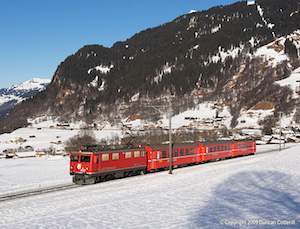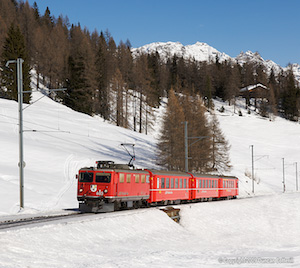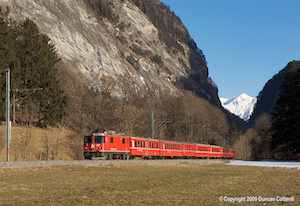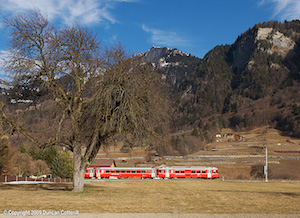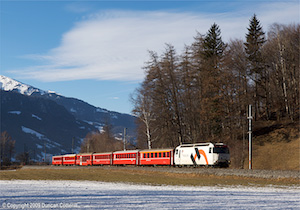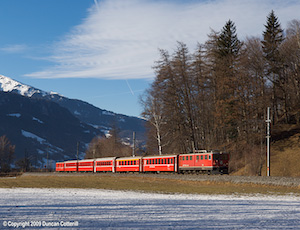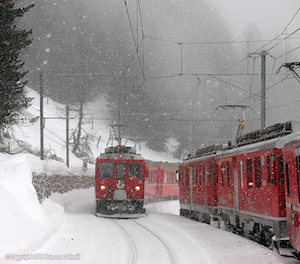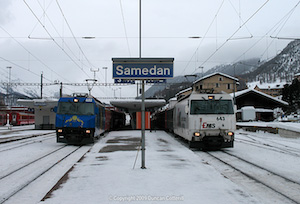Winter in Rhätischeland
07 - 19 January 2009
Report by Duncan Cotterill
Introduction
The Rhätischebahn operates a large network of metre gauge lines in the south-eastern Swiss canton of Graubünden. The railway serves the industrialised area around the regional capital, Chur, as well as the Alpine resorts of Klosters, St. Moritz and Davos and even reaches Italy via the Bernina Pass, the highest adhesion-only crossing of the Alps. There are regular passenger services, most of them locomotive hauled, and a surprising volume of freight traffic all running through superb alpine scenery.
After a short trip to the Rhätischebahn in December 2007, I resolved to go back for a longer period in winter 2008/2009. This is the report of that trip, from 07 to 19 January 2009.
Passenger Services
The RhB’s passenger service consists of a number of different routes, each operating at hourly intervals for most of the day and most connecting with the others at strategic points. There are a number of variations at the beginning and end of the day but they aren’t covered here. Note also that this report only deals with the winter sports season, which runs until March 2009. Spring and late autumn / early winter are much quieter and while the summer and early autumn are busy, the pattern of service is different in places. RhB services connect with those of the SBB at Chur and Landquart, the MGB, formerly Furka Oberalp at Disentis/Muster and with FS at Tirano, just across the Italian border.
Chur to St. Moritz
This is the RhB’s premier passenger service running from the regional capital, Chur, to St. Moritz in the Ober Engadin via the Albula Tunnel, a spectacular route that climbs almost 1200m, with many tunnels and viaducts and several spirals. Most passenger trains are hauled by class Ge4/4III locomotives in advertising liveries although there is a diagram for a Ge4/4II on trains 1109, 1124, 1133, 1148, 1157 and 1172. This turn has often been covered by a Ge6/6II, however, during much of my visit, all 12 of the Ge4/4IIIs were available, allowing all the Chur – St. Moritz trains to be covered by Ge4/4IIIs. Trains can be very long, particularly those that convey Glacier Express or Bernina Express portions. 15 coaches was the maximum seen!
Disentis/Muster to Scuol-Tarasp
This service links the extremities of the RhB system running over 140km from the MGB interchange at Disentis/Muster in the far west, down the Vorderrhein Valley to Chur and Landquart then up the Prättigau Valley to Klosters, through the Vereina Tunnel into the Unter Engadin and terminating at Scuol-Tarasp. All passenger services are booked to be hauled by class Ge4/4II locomotives and they usually were during my visit. Occasionally, Ge6/6II were used, particularly at weekends when the Ge4/4IIs were in demand elsewhere.
Landquart to Davos
This service follows the same route as the Disentis/Muster - Scuol-Tarasp trains between Landquart and Klosters before climbing out of the Prättigau and dropping into Davos at the head of the Landwasser Valley. All trains are normally worked by push-pull sets with the loco at the Davos end. There are diagrams for three Ge4/4III and two Ge4/4II locos covering the Landquart – Davos and Davos – Filisur trains. Note that the two classes of loco don’t normally interchange. There is a three day diagram for Ge4/4III and a two day diagram for Ge4/4II. During my visit, there were several days when one of the Ge4/4IIIs wasn’t available and a third Ge4/4II substituted. At weekends, the trains are very busy and pairs of Ge4/4IIs are required for the heaviest workings
The method of operation is fairly complex with a lot of shunting at each end that appears to negate the benefits of using push-pull equipment. Trains leave Landquart with the loco leading a 4-car push-pull set, usually with two or three additional coaches tacked on the back behind the driving trailer. However, as many as five extra coaches have been seen on busy days. At Davos, the additional coaches are removed by the station pilot and, after around 30 minutes, the 4-car push-pull set leaves for Filisur with the loco leading. Around an hour later, the train returns from Filisur with the driving trailer leading. The station pilot then shunts additional coaches onto the back, sandwiching the loco in the middle of the formation. This train then leaves for Landquart after another 30 minutes. At Landquart, the station pilot removes the additional coaches from the train and shunts more onto the other end and the whole process repeats.
Davos to Filisur
This used to be a self-contained service but since the December 2008 timetable change it has been operated as an extension of the Landquart – Davos service using Ge4/4II and Ge4/4III locomotives at the Filisur end of 4-car push-pull sets. Trains run down the Landwasser Valley from Davos to Filisur on the Chur – St. Moritz line and are timed to connect with main line services at Filisur. See also Landquart – Davos above but note that the additional locos and coaches mentioned only run as far as Davos and don’t continue to Filisur.
Pontresina to Scuol-Tarasp
This service runs down the Engadin Valley from Pontresina in the Ober Engadin to Scuol-Tarasp in the Unter Engadin. It connects with Chur – St. Moritz services at Samedan and with Scuol-Tarasp – Disentis services at Sagliains. Four push-pull sets are employed, worked by two Ge4/4I and two Ge4/4II locomotives. The loco is always at the Scuol-Tarasp end of the train. There is a single 4-day diagram and all the locos rotate through it irrespective of class. On any particular day, three sets are required to work the hourly Pontresina – Scuol-Tarasp trains with the fourth set employed on shorter peak hour workings in the Ober-Engadin, e.g. St. Moritz – S-Chanf and v.v. There were consistently two Ge4/4Is and two Ge4/4IIs employed on these trains during my visit. It’s surprising that the Ge4/4Is should gain these relatively high mileage duties at a time when the use of the class elsewhere is in such sharp decline.
Chur to Arosa
In recent years these services have been operated by push-pull sets but this year most are hauled in both directions. Three hauled sets and a push-pull set seemed to be the norm. Four locos are required to operate the basic service with a fifth needed at weekends when there are extra trains. Ge4/4IIs are generally used although a Ge4/4I can appear from time to time, particularly on busy weekends when some trains are heavy enough to require double headed Ge4/4II.
Chur to Thusis & Schiers to Rhäzüns Locals
These local services cover the Chur and Landquart area and are worked by class Be4/4 motor coaches coupled to two intermediate trailers and a driving trailer. The motor coach is always at the Chur end. Both services operate at hourly intervals throughout the day, including weekends. Four sets are required to work the service.
Winter Sports Services
These trains run for the benefit of skiers, sledgers and the like but are open to use by anyone with a valid ticket. In the case of the Klosters Dorf – Davos trains, they replace stops by the Regio-Express services at smaller stations.
There are hourly services from Bergün to Preda while the sledging run between the two places is operating, nominally until 7 March 2009. Unlike most services, these trains only carry passengers in an uphill direction, returning to Bergün empty stock. A single push-pull set covers all workings. The loco is always at the Preda end and is almost always a Ge4/4I.
The second service runs between Klosters Dorf and Davos Platz and is a little more conventional in that it carries passengers in both directions. Two push-pull sets are required to operate the service and both are booked to be worked by Ge4/4Is with the loco at the Davos end. During my stay, one train was always Ge4/4I worked but the other was initially a Be4/4 motor coach and trailers as used on local services in the Chur area. This was said to be due to the usual set of coaches being under repair but after a few days when the coaches became available, the second train was worked by a Ge4/4II. One unusual feature of the service is that the set returns empty from Klosters Dorf to Klosters between trips. This is due to there only being two tracks at Klosters Dorf and they are both required for other services to cross.
St. Moritz to Tirano
The Berninabahn is part of the RhB system but uses a 1000V DC electrical system instead of the 11kV AC found on the rest of the network and therefore requires it’s own dedicated motive power. Most trains consist of several coaches hauled by one or two motor coaches but occasionally one of the line’s two locomotives is used. These are actually electro-diesels able to operate on diesel power away from the Bernina’s electrification but they rarely stray far. Even the Bernina Express tourist trains are usually worked by a pair of motor coaches, ensuring at least some accommodation for ordinary passengers.
During my stay the line was closed south of Poschiavo due to a rockfall in the Brusio area and there were plenty of motorcoaches available to cover the truncated services. As a consequence the locos saw relatively little use. One curiosity was the use of a vintage motorcoach to operate snow clearing trains in the Alp Grüm and Ospizio Bernina area on several days. The line south of Poschiavo is expected to reopen sometime in March.
Tourist Trains
The RhB operates services aimed at tourists under the Bernina Express and Glacier Express banners, the latter in conjunction with the MGB.
The winter Bernina Express service consists of daily Chur – Tirano & v.v. and Tirano – St. Moritz & v.v. workings but these actually run as portions of the regular hourly services, with a couple of exceptions. As the line is currently closed south of Poschiavo, the Bernina Expresses only reach Tirano via a bus connection at the moment. On busy days, the Bernina Express coaches can run as a separate train from Chur to Pontresina, following the 08:58 departure from Chur. The rest of the time, they are divided from the St. Moritz train at Samedan. The train engine then takes the Bernina Express coaches to Pontresina and another loco, usually a Ge4/4I or Ge6/6II hauls the regular coaches to St. Moritz. On the return trip, the Bernina coaches are simply added to the back of a regular Scuol-Tarasp train at Pontresina and then shunted onto the back of the Chur service at Samedan.
The winter Glacier Express service runs attached to regular trains between St. Moritz and Chur but is then worked as a separate train to Disentis where the MGB takes over for the run to Zermatt. The same happens in the reverse direction. Motive power is almost always a Ge4/4II on the Chur - Disentis leg.
Freight Trains
There is a surprisingly large amount of freight traffic on the RhB but then this is Switzerland and they do have a far more enlightened approach to freight transport than most countries. Commodities include fuel, cement, mineral water, containers for supermarkets, timber, general goods and rubbish. The busiest flows are between the Chur/Landquart area and Ilanz on the Disentis line and Samedan on the St. Moritz line but freight trains reach most parts of the system, including Pontresina, Scuol-Tarasp, Davos and Disentis, every weekday. Freights are timetabled and generally run pretty close to schedule. There are a couple of workings on Saturdays but most freights run Monday to Friday only. The magnificent Ge6/6II Bo-Bo-Bos are used on the heavier trains with Ge4/4Is and Ge4/4IIs on most of the shorter, lighter workings. There has been a marked decrease in the use of Ge4/4Is over the past year and they can be difficult to find on freight workings, even in winter when the motive power requirement is at its height due to the winter sports traffic. Ge4/4IIIs do appear regularly on freights but usually only on a very early morning Landquart – St Moritz train that few people see.
Day By Day
Wed 07 Jan 2009
British Airways got me into Zürich on time, despite a delay for de-icing at Heathrow, and just over 30 minutes later I was boarding an S-Bahn train bound for Zürich HB. A 3 minute connection at HB didn’t seem achievable, especially as the S-Bahn platforms are some distance from the main concourse, but there is an underpass I hadn’t known about that got me onto the right platform with a minute or so to spare. The nearest coach was the driving trailer so I leapt onboard, followed by an English couple off the same S-Bahn train, to find a completely empty single deck coach, isolated from the rest of the double deck train. Bliss! Unfortunately not, the other two moaned, whined and whinged all the way to Landquart because there was no buffet service and they couldn’t go and whine to their friends in the back of the train. From Landquart, the RhB took me to Davos for the annual ritual of timetable buying and then onto Filisur and my base for the trip, the Hotel Grischuna, conveniently located at the south end of platform 1.
Thu 08 Jan 2009
I decided to start my photographic activities at a familiar location and spent the day around Bever where the line from Chur to St. Moritz joins the line from Scuol-Tarasp to Pontresina in the Ober-Engadin. There was a fair bit of cloud hanging over the mountains to the south but it never really caused any problems and once the sun climbed above the mountains, every shot was in brilliant sunshine. One of the Chur-St. Moritz passenger turns was booked for Ge6/6II 701 but 707 also appeared on a second turn while 703 and 706 were seen on freights. Ge4/4I 610 was working Pontresina – Scuol-Tarasp trains, making it a very good day to visit the Ober-Engadin. Despite the temperature being a long way below zero, there was no wind and it was actually very pleasant waiting in the sunshine for the next train to arrive.
Fri 09 Jan 2009
A second day in the Ober-Engadin but concentrating on the Celerina area this time. Ge6/6II 703 was working one of the Chur-St. Moritz passenger turns and Ge4/4I 604 worked the Samedan to St. Moritz section of RE1125 while the train engine took the Bernina Express coaches to Pontresina.
A midday hike over to Pontresina found Ge4/4Is 610 and 609 on consecutive departures for Scuol-Tarasp.
Then it was another rapid hike back to Celerina for some afternoon trains. Typically, I found the best location after the sun had dropped behind the mountains. The light was excellent all day.
Sat 10 Jan 2009
With two Ge4/4Is working Pontresina – Scuol-Tarasp passengers and two Ge6/6IIs on Scuol-Tarasp – Disentis passengers, the only place to be was the Unter-Engadin. Most of the day was spent around Ardez, one of the few spots in the deep valley to get a reasonable amount of sunlight, and then Scuol-Tarasp itself when Ardez went into shadow. 609, 610, 702 and 706 produced as expected. Another day of wall-to-wall sunshine.
Sun 11 Jan 2009
Time for something a little different. I travelled to Disentis/Muster and changed onto the connecting MGB train to Andermatt. This was my first visit to the eastern end of the MGB but it was clear from the maps that there were two areas which would get more sunlight than the rest. The first was just out of Disentis and the second around Sedrun.
As we climbed out of Disentis, some reasonable locations were spotted in the first few km. I decided to get off at Segnas, the second station out, but the train didn’t stop. I’d got too used to the RhB with its comprehensive announcements and buttons to signal that you want the train to stop. Apparently the old fashioned method of telling the conductor applies on the MGB – whatever next?
We did stop at the third station, Mompe-Tujetsch and I spent the day walking back to Acla Da Fontauna, the first station out of Disentis, photographing along the way. All the scheduled passenger services were loco hauled with numbers 101, 102, 103, 104, 106, 107 & 108 all being seen. There was an additional working with Glacier Express stock down the hill in advance of the real eastbound Glacier, probably a private charter of some sort as it was waiting to go back west, complete with passengers, when I got down to Disentis. The only non loco hauled train that I saw was worked by motor baggage van 54 and went down to Disentis empty stock passing Segnas at 11:20. Once more the sun shone all day.
Mon 12 Jan 2009
Back to the RhB proper. There was a Ge4/4I booked on the morning freight to Ilanz. Although this is diagrammed, the train was often worked by a Ge4/4II during my visit. The section east of Ilanz is one of the best on the RhB for freight and with Ge4/4II hauled passengers and some excellent photographic locations as well, there are few more rewarding places to spend a day. The Ge4/4I didn’t produce but Ge6/6II 702 was an acceptable substitute. 707 and 701 also appeared on the Disentis freights.
It was at this point that the unspeakably hideous 611 started to haunt me and I spent the rest of the trip trying to avoid it. This is the only Ge4/4II in advertising livery and it makes me nauseous just to look at it. However much I may dislike some of the Ge4/4III paint schemes, they are all reasonably tasteful, unlike this toxic yellow abomination. I had to put the camera down and shield my eyes when it appeared. Otherwise, the day was excellent with brilliant light from start to finish once again.
Tue 13 Jan 2009
Back to Celerina initially, to try some against the light shots first thing. Then it was down the hill to Bergün where 606 was working the Schlittelzüge to Preda. I was also rewarded with shots of 703 and 705 on freights. The curves above Bergün are difficult to photograph in winter as the sun doesn’t get on the track until well after 11:00 and before long, it’s gone behind the mountains again.
The day’s final location was the amazing Landwasser Viaduct just north of Filisur. There’s a footpath from the valley floor up to an overlook on the north side of the valley but with deep snow everywhere the climb could have been very difficult. Fortunately, someone had been up the path before and done the hard work so it wasn’t too difficult to get there, although treacherously icy in places. I was rewarded with Ge4/4I 608 on freight and several Ge4/4IIIs on passengers before the sun finally disappeared at 15:40 after yet another brilliantly sunny day.
Wed 14 Jan 2009
Well, it had to happen eventually. Cloud and lots of it. The forecast was best in the north so I set off towards Klosters initially, with the idea of photographing the Ge4/4I on the Davos shuttles. Klosters was just as dull but at least there was blue sky on the northern horizon. Plan B was to continue to Malans, near Landquart where the line runs in front of some nice hills. Unfortunately, the clear sky was nearer to Lindau than Landquart so it was on to plan C, explore the Arosa line. Approaching Chur, more blue sky was spotted to the west, and not so far away either. Time to create plan D, keep going west towards Disentis.
By Ilanz the cloud was thinning and by Trun the sky was clear blue. It was almost midday but I could still have a good afternoon’s photography. Walking east of the station, I happily photographed until the sun went behind the mountains at 12:15. Getting the light is a real problem in these long, deep, east-west valleys. There are many places that are permanently in shadow all winter. The really shady spots are relatively easy to spot because the snow remains on the trees long after it’s thawed in the sunnier areas. You need to look on the map for places where a side valley to the south allows the light to get in. Fortunately, Trun is one of those places and it wasn’t long before the line to the west of town was lit again. An excellent afternoon was had photographing the regular passengers, the eastbound Glacier Express and the highlight, 707 on the afternoon goods to Disentis.
Thu 15 Jan 2009
Back to normal, brilliant sunshine all day. Time to have another go at the Klosters – Davos shuttles. The section between Klosters Dorf and Klosters is easily accessible from a footpath that parallels the line and there are a couple of very acceptable locations. It’s also very busy with no less than eight movements scheduled every hour, excluding any freights. Not bad for a single-track line. After a couple of hours, I changed location to Davos Wolfgang for some more shots of the shuttles. The snow here was very deep and although I was used to stumbling through snow up to knee height, here it was up to waist height in places but it wasn’t obvious where until you put your foot down and it just kept going. It’s one thing climbing out of a knee deep hole but a waist deep one is a different matter and requires the use of the camera bag and both arms to spread your weight as much as possible. I hate to think what would have happened if I’d gone in to waist height with both feet?
603 and 621 were working the shuttles and there was an extra Ge4/4II on the Landquart – Davos trains, giving me plenty to phot until 641 in white Co-op livery turned up on one of the afternoon workings to spoil things. White engines in a snowy landscape just don’t look very good. One of the more attractive Werbeloks, 652 waited until the light had gone before appearing but I’d got a very nice shot of it at Klosters in the morning so I can’t complain.
Fri 16 Jan 2009
Friday was the last chance to get some freight workings and I returned to Ilanz, where a Ge4/4I was booked for the morning goods again. This time it did produce and 608 was duly recorded rounding the curve east of town at 11:00. Five days earlier, the same spot had been in deep shadow at the at the same time so spring must be on its way. A couple of freights and several passengers later, the sky was starting to get a bit milky to the south-west so it was off to Malans where it looked clearer. By the time I got there it was too late to do very much but I did get a few shots and the chance to check out more positions. Another brilliantly sunny day although I had to move to make the most of it.
Sat 17 Jan 2009
A cloudy start. The forecast indicated it would be fairly cloudy everywhere so I set off towards Klosters again with the idea of moving on to Malans if it was better there, or exploring the Arosa line if I couldn’t find the sun. There were some breaks by the time I got to Klosters, so an hour was spent on the bank just out of town with around half the trains passing in sun, including the weekends only Landquart to St. Moritz train with 707 on the front. When the sun moved round I continued down the valley to Malans, deftly avoiding the dreaded 611, which passed in the opposite direction while I was travelling.
Malans was beautifully sunny and kept me busy with a constant procession of trains including 704 on RE1245. It was really novel to stand on firm ground and photograph trains in a landscape largely devoid of snow for a change.
A lot of people go out of their way to avoid units but the 4-car sets working locals out to Schiers make superb photographs in the Alpine landscape. It’s probably more about them being red than anything else. I’d far rather photograph the nice red Be4/4s than the majority of the Werbeloks, let alone 611. If the new units promised for next year are finished in a tasteful red livery, I could even bring myself to photograph them as well.
Sun 18 Jan 2009
Another dull start. I set off with two plans in mind, either do the Arosa line or spend the day riding most of the sections of line I hadn’t done before. It soon became clear that it was going to be a very dull day so the second plan won. This involved taking the 08:01 train from Filisur to Chur then connecting into the SBB IC service to Zürich, which should have got me to Landquart a whole 3 minutes before RE1327 left for St. Moritz at 09:20. In fact, the station clock read 09:18:50 by the time we arrived so I had to run for it, getting on with a whole 10 seconds to spare. Although the presence of the magnificent 707 on the front would have justified the trip, the real reason for riding RE1327 was that it takes the western curve out of the Vereina Tunnel, avoiding Sagliains, one of very few passenger services to do so. The next section of new track was from Celerina to St. Moritz, which appeared to have about as much photographic potential as the inside of the Vereina Tunnel.
From St. Moritz, I continued over the Berninabahn, a line I’d only done from Pontresina to Ospizio Bernina before and then in the benign conditions of early October. It’s a completely different world in winter. While the footpaths are generally kept open lower down, up on the top everything apart from the railway had been abandoned until the spring. In places, all you could see of the footpaths were the tops of the direction signs poking out of four-foot snowdrifts. Elsewhere, there was no trace of them at all. At one level crossing near the summit the bells sounded and the lights flashed forlornly at a spot no pedestrians or vehicles could get within miles of for several months. Low cloud shrouded Lago Bianco, obscuring any views of the nearby peaks and glaciers and there was a blizzard in progress at Ospizio Bernina to complete the total white out. The great plumes of snow kicked up by the ploughs on the lead unit didn’t help the visibility either, rather like travelling behind a steam loco with its drain cocks jammed open. Riding through this hostile wilderness was quite an experience by any standards.
Any hope of better weather on the south side of the pass soon evaporated. It was snowing heavily all the way down to Privilasco, one stop short of Poschiavo, where I baled out to avoid a wait of almost an hour for the next train back. Going back up the pass it was noticeable that a lot of snow had fallen in the short time that had passed. Yet through all this, the railway continued to operate and kept to time as well. What an impressive operation!
Going back a few hours… At Landquart there was a Ge4/4II instead of the expected Ge4/4III on the train that had just arrived from Davos. In the rush to change trains I thought no more of it. A little later, at Samedan, Ge4/4III 652, a Davos line stalwart, was at the depot, coupled to a set of coaches but without a driving trailer. Checking the schedule, 652 had been booked to work the Davos train I’d seen, so that explained the Ge4/4II seen at Landquart. Arriving back at Pontresina from the Bernina, another piece of the jigsaw was about to fall into place. Instead of the anticipated Ge4/4II on a push-pull set, the train from Scuol-Tarasp arrived in the form of 511, one of the Be4/4 motor coach sets usually found on locals in the Chur area. This particular unit had been spare at Landquart since I’d arrived over a week previously. On the return working everyone was turfed off at Samedan and passengers to Scuol-Tarasp were ushered forward to a push-pull set with 652 on the front. Amazing how one failure, presumably of the driving trailer, could result in so many unusual workings.
Mon 19 Jan 2009
Another dull start but it didn’t matter this time as I was going home, by rail to Zürich Flughafen then air to Heathrow. Overtaking freight 5120 with 703 at Tiefencastel, I noticed a driving trailer coupled behind the locomotive, presumably the one that had caused all the trouble the previous day. RhB and SBB got me back to Zürich Flughafen on time and BA were only a few minutes late into Heathrow despite the outward leg getting to Zürich almost an hour late.
Comments and Conclusions
What a fabulous start to 2009. Over nine days of clear sunshine out of eleven days at the lineside is difficult to beat anywhere in the world at any time of year. Add the stunning alpine scenery, lots of snow, deep blue skies and, not least, the superb red trains of the Rhätischebahn to make one of the best trips I’ve had for a long time.
Big changes are on the way for the RhB, with no less than twenty 3 and 4 car EMUs on order from Stadler for delivery from early 2010 onwards. The first five dual-voltage units are scheduled to replace older motor coaches on the Bernina, followed by another five AC only units to replace the Be4/4 motor coach sets operating in the Chur/Landquart area. These could then be used to displace Ge4/4Is but I've seen nothing to indicate that it will happen. This information comes from an RhB press release dated 22 Dec 2008. The remaining ten sets, to be delivered later, will inevitably lead to a reduction in the number of loco hauled workings and, almost certainly, the elimination of the class Ge4/4Is, most of which are now over 60 years old. The reduction in work for the Ge4/4Is since last year has been quite marked but at least the majority should see out 2009. After that, who knows?
The RhB makes a lot of useful information available on its website and elsewhere, even graphical timetables that show all the freights, empty stock workings and light engine movements as well as the publicly advertised passenger trains. The loco diagrams are also available although there are usually day-to-day alterations. For the most up to date information, the details of each days workings, complete with loco numbers are published late the previous afternoon, so you can see what’s running and where and draw up your plans accordingly. These are posted at Bergün station and copies can be obtained from the café at Filisur station for SFr2. Just ask for the “Lok Dienst für Morgen” (loco duties for tomorrow).
Graphical Timetables from www.fahrplanfelder.ch
Chur - Disentis
Chur - St. Moritz, La Punt - Pontresina
Chur - Landquart - Klosters - Davos Platz
Davos Platz - Filisur, Chur - Arosa
Klosters - Scuol Tarasp, Sagliains - Pontresina
St. Moritz - Tirano (Winter)
St. Moritz - Tirano (Summer)
Switzerland was never a cheap place to visit but the pound’s recent nosedive against other currencies has made it considerably more expensive, about 40% up on last year purely on exchange rates. However, in terms of the number of pounds per good picture, it still holds its own. It’s not just the pictures, it’s also a very pleasant place to visit in every respect.
I used a Monthly BÜGA ticket to get around. This gives unlimited travel on all trains and most bus services within Graubünden canton, so it covers the whole of the RhB, the MGB as far west as Oberalppasshöhe and SBB between Chur, Landquart and Maienfeld. For longer trips to the RhB it works out much more economical than any of the other options available, such as the Swiss Pass or Inter Rail, as long as you intend to stay within the Graubünden area. My First Class pass cost SFr270 and I paid SFr38 each way to get from and to the airport in Second Class (The shame of it!). A Swiss Pass would have cost around SFr600 in Second Class and SFr900 in First for 12 days. Even using the pass for less than a third of it's period of validity was worthwhile. A few checks on prices at various ticket machines while waiting for trains revealed that I'd done over SFr1000 worth of travel without really trying. There's more information on the BÜGA and how to apply for one in English on the RhB website.
As I mentioned in last winter’s report, for such a superb system, there seemed to be remarkably few enthusiasts about when conditions were arguably at their best. It was good to meet Don and Sue Gatehouse at the Grischuna and there were a handful of others around, even one guy photographing at Alp Grüm in the middle of a blizzard – now that’s dedication! Given the coming changes, I’m surprised that there weren’t more people out taking pictures. I’m certainly planning to go back for more!
